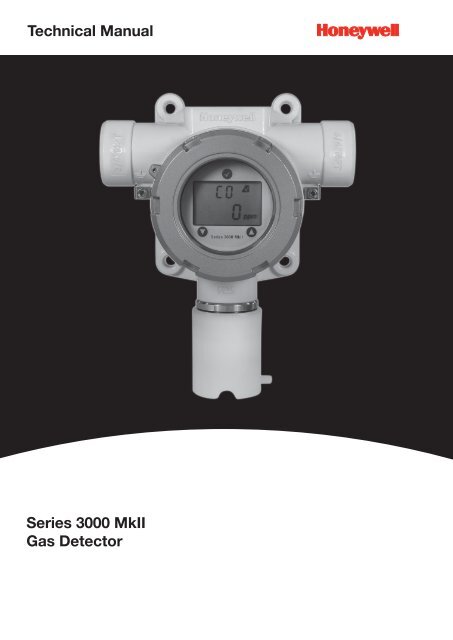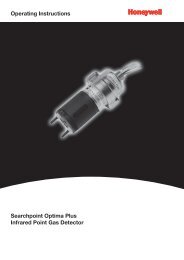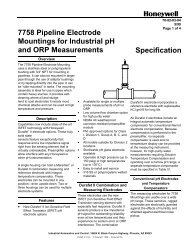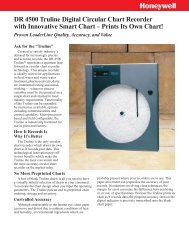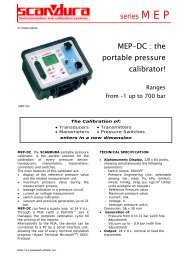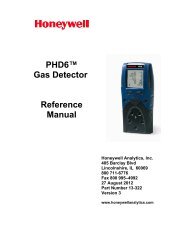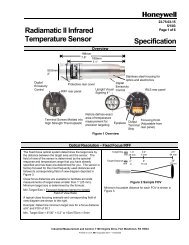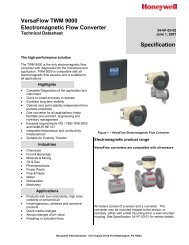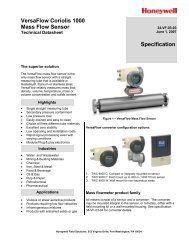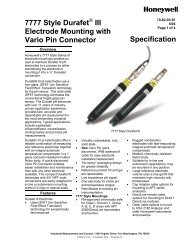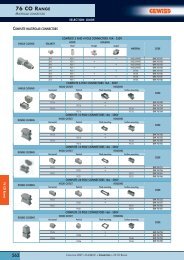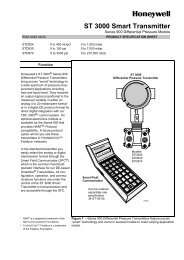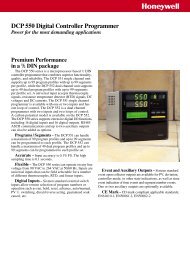Technical Manual Series 3000 MkII Gas Detector - Merkantile
Technical Manual Series 3000 MkII Gas Detector - Merkantile
Technical Manual Series 3000 MkII Gas Detector - Merkantile
Create successful ePaper yourself
Turn your PDF publications into a flip-book with our unique Google optimized e-Paper software.
<strong>Technical</strong> <strong>Manual</strong><br />
<strong>Series</strong> <strong>3000</strong> <strong>MkII</strong><br />
<strong>Gas</strong> <strong>Detector</strong>
SERIES <strong>3000</strong> MKII TECHNICAL MANUAL<br />
S3KMKIIMAN_MAN0878_Issue 1_01-10<br />
1 Safety<br />
Ensure that this Operating <strong>Manual</strong> is read and understood BEFORE installing / operating /<br />
maintaining the equipment.<br />
Pay particular attention to Warnings and Cautions.<br />
All document Warnings are listed here and repeated where appropriate at the start of the<br />
relevant chapter(s) of this Operating <strong>Manual</strong>.<br />
Cautions appear in the sections/sub-sections of the document where they apply.<br />
WARNINGS<br />
<strong>Series</strong> <strong>3000</strong> <strong>MkII</strong> is designed for installation and use in Zone 1 or 2 hazardous areas<br />
in Europe and Class I Division 1 or 2 and Class II Division 1 or 2 area applications in<br />
North America.<br />
Installation must be in accordance with the recognized standards of the appropriate<br />
authority in the country concerned.<br />
Access to the interior of the detector, when carrying out any work, must only be<br />
conducted by trained personnel.<br />
Before carrying out any work ensure local regulations and site procedures are<br />
followed. Appropriate standards must be followed to maintain the overall<br />
certification of the detector.<br />
To reduce risk of ignition of hazardous atmospheres, conduit runs must have a seal<br />
fitting connected within 18 inches of the enclosure.<br />
To reduce the risk of ignition of hazardous atmosphere, de-classify the area or<br />
disconnect the equipment from the supply circuit before opening the detector<br />
enclosure. Keep assembly tightly closed during operation.<br />
Never attempt to open a junction box/enclosure in potentially hazardous<br />
atmospheres.<br />
The detector must be earthed/grounded for electrical safety and to limit the effects<br />
of radio frequency interference. An earth/ground point is provided inside and<br />
outside the unit. The internal grounding shall be used as the primary equipment<br />
ground. The external terminal is only a supplemental bonding connection where<br />
local authorities permit or require such a connection.<br />
The enclosure of the remotely mounted sensor assembly contains Aluminum. Care<br />
must be taken to avoid ignition hazards due to impact or friction when installed in a<br />
Zone 1 location.<br />
Take care when handling sensors as they may contain corrosive solutions.<br />
Do not tamper or in any way dis-assemble the sensor.<br />
Do not expose to temperatures outside the recommended range.<br />
Do not expose sensor to organic solvents or flammable liquids.<br />
At the end of their working life, sensors must be disposed of in an environmentally<br />
safe manner. Disposal should be according to local waste management<br />
requirements and environmental legislation.<br />
Alternatively, sensors may be securely packaged and returned to<br />
Honeywell Analytics clearly marked for environmental disposal.<br />
Electrochemical cells should NOT be incinerated as they may emit toxic fumes.<br />
2
SERIES <strong>3000</strong> MKII TECHNICAL MANUAL<br />
S3KMKIIMAN_MAN0878_Issue 1_01-10<br />
2 Information<br />
Honeywell Analytics can take no responsibility for installation and/or use of its<br />
equipment if this is not done in accordance with the appropriate issue and/or<br />
amendment of the Operating <strong>Manual</strong>.<br />
The reader of this Operating <strong>Manual</strong> should ensure that it is appropriate in all details<br />
for the exact equipment to be installed and/or operated. If in doubt, contact<br />
Honeywell Analytics for advice.<br />
The following types of notices are used throughout this Operating <strong>Manual</strong>:<br />
WARNING<br />
Identifies a hazardous or unsafe practice which could result in severe injury<br />
or death to personnel.<br />
Caution: Identifies a hazardous or unsafe practice which could result in<br />
minor injury to personnel, or product or property damage.<br />
Note: Identifies useful/additional information.<br />
Every effort has been made to ensure the accuracy of our documents, however,<br />
Honeywell Analytics can assume no responsibility for any errors or omissions in our<br />
documents or their consequences.<br />
Honeywell Analytics greatly appreciates being informed of any errors or omissions<br />
that may be found in the contents of any of our documents.<br />
For information not covered in this document, or there is a requirement to send<br />
comments/corrections about this document, please contact Honeywell Analytics<br />
using the contact details given on the back page of this document.<br />
Honeywell Analytics reserve the right to change or revise the information<br />
supplied in this document without notice and without obligation to notify any<br />
person or organization of such revision or change. If information is required<br />
that does not appear in this document, contact the local distributor/agent or<br />
Honeywell Analytics.<br />
3
SERIES <strong>3000</strong> MKII TECHNICAL MANUAL<br />
S3KMKIIMAN_MAN0878_Issue 1_01-10<br />
3 Table of contents<br />
1 Safety........................................................................................................................................2<br />
2 Information................................................................................................................................3<br />
3 Table of contents ......................................................................................................................4<br />
4 Introduction ...............................................................................................................................5<br />
4.1 Product overview ...................................................................................................................5<br />
4.2 Transmitter.............................................................................................................................5<br />
4.3 Smart sensor .........................................................................................................................6<br />
4.4 Accessories ...........................................................................................................................6<br />
4.4.1 Pipe mounting bracket........................................................................................................6<br />
4.4.2 Sunshade / Deluge Protection............................................................................................6<br />
4.4.3 Remote sensor mounting kit...............................................................................................6<br />
4.4.4 Duct mounting kit................................................................................................................6<br />
4.4.5 Calibration gas flow housing...............................................................................................6<br />
4.4.6 Collecting cone ...................................................................................................................7<br />
5 Installation.................................................................................................................................8<br />
5.1 Mounting and location of detectors........................................................................................9<br />
6 Electrical connections.............................................................................................................11<br />
6.1 <strong>Detector</strong> wiring schematic ...................................................................................................12<br />
6.2 Typical maximum installed cable lengths ............................................................................12<br />
6.3 Terminal connections ..........................................................................................................13<br />
6.4 Cable and earth/ground connection ....................................................................................13<br />
7 First time switch on.................................................................................................................15<br />
8 Magnetic switch activation......................................................................................................16<br />
8.1 Default configuration............................................................................................................17<br />
8.2 Calibration............................................................................................................................18<br />
8.2.1 Zeroing and span calibration ............................................................................................18<br />
8.2.2 Zeroing and span calibration of Hydrogen Sulfide sensors..............................................21<br />
9 Display and user interface ......................................................................................................22<br />
10 Monitoring mode...................................................................................................................24<br />
11 Review mode........................................................................................................................24<br />
12 Menu mode...........................................................................................................................24<br />
12.1 Menu mode operation table...............................................................................................25<br />
13 <strong>Detector</strong> fault/warning message display...............................................................................26<br />
13.1 <strong>Detector</strong> fault/warning operation........................................................................................26<br />
13.2 Reflex cell fault diagnosis ..............................................................................................26<br />
14 General maintenance ...........................................................................................................27<br />
14.1 Functional gas test ............................................................................................................27<br />
14.2 <strong>Detector</strong> operational life.....................................................................................................28<br />
15 Servicing ...............................................................................................................................29<br />
15.1 Sensor replacement ..........................................................................................................29<br />
15.2 Serviceable sensor cell replacement.................................................................................31<br />
16 Remote sensor mounting kit installation details ...................................................................32<br />
17 General specifications ..........................................................................................................34<br />
18 Ordering information.............................................................................................................35<br />
19 Warranty/liability statement ..................................................................................................36<br />
20 CE certificates.......................................................................................................................37<br />
21 Certification...........................................................................................................................39<br />
21.1 UL/CSA control drawing ....................................................................................................39<br />
21.2 Sensor Cartridge and Remote Sensor Accessory control drawing...................................40<br />
21.3 Main unit UL/CSA hazardous area nameplate..................................................................41<br />
21.4 Main unit ATEX/IECEx hazardous area nameplate ..........................................................41<br />
21.5 Sensor label ATEX/UL/ULc ...............................................................................................41<br />
21.6 Remote sensor ATEX/UL/cUL hazardous area nameplate...............................................42<br />
4
SERIES <strong>3000</strong> MKII TECHNICAL MANUAL<br />
S3KMKIIMAN_MAN0878_Issue 1_01-10<br />
4 Introduction<br />
The <strong>Series</strong> <strong>3000</strong> <strong>MkII</strong> gas detector is designed to detect toxic or oxygen gas hazards<br />
in Zone 1 or 2 hazardous areas in Europe and North American Class I Division 1 or 2<br />
areas and Class II Division 1 or 2 areas. A local LCD provides gas type and<br />
concentration information and when magnetically activated enables non intrusive one<br />
man calibration and operation. The sensor interface to the transmitter is Intrinsically<br />
Safe (IS) allowing it to be ‘hot swapped’ without the need for removing power to the<br />
detector. The replacement plug in smart sensors are supplied pre-calibrated. A<br />
remote sensor mounting kit allows the sensor to be mounted up to 50 feet (15<br />
meters) from the explosion proof transmitter housing. The output from the transmitter<br />
is an industry standard 2 wire 4-20mA loop (sink) suitable for connection to a wide<br />
range Honeywell Analytics or 3 rd party control equipment/PLCs.<br />
4.1 Product overview<br />
The <strong>Series</strong> <strong>3000</strong> <strong>MkII</strong> detector comprises of the main parts shown below.<br />
Terminal Module and<br />
IS Barrier<br />
Locking Screw<br />
Cover<br />
M20 or 3/4"NPT<br />
cable/conduit entry (x2)<br />
Transmitter Enclosure<br />
Seal<br />
Display Module<br />
Smart Sensor<br />
Sensor Retainer<br />
Diagram 1: <strong>Series</strong> <strong>3000</strong> <strong>MkII</strong> Exploded View<br />
Weatherproof Cover<br />
4.2 Transmitter<br />
The transmitter cover has a glass window which allows use of the magnet to activate<br />
the three user interface magnetic switches that are located on the front of the display<br />
module. This allows for non intrusive set up and operation. The display provides both<br />
numerical and icon information.<br />
Calibration Icon<br />
Magnetic<br />
Test Pass Icon<br />
MENU/ENTER<br />
Switch<br />
Warning/Fault Icon<br />
<strong>Gas</strong> Type<br />
<strong>Gas</strong> Reading<br />
Inhibit Icon<br />
Measuring Units<br />
Magnetic<br />
DOWN Switch<br />
Magnetic<br />
UP Switch<br />
Diagram 2: <strong>Series</strong> <strong>3000</strong> <strong>MkII</strong> Display and Magnetic Switches<br />
5
SERIES <strong>3000</strong> MKII TECHNICAL MANUAL<br />
S3KMKIIMAN_MAN0878_Issue 1_01-10<br />
The cover can be unscrewed to allow removal of the display module. Beneath the<br />
display module is the terminal module and IS barrier where all electrical connections<br />
to the detector are made.<br />
Electrical connections are made via 2 x M20 cable entries or 2 x 3/4"NPT conduit<br />
entries (certification dependent). A suitable blanking plug is supplied which must be<br />
used to seal any unused entry.<br />
The smart sensor plugs into the bottom of the transmitter and is secured by the<br />
sensor retainer. The weatherproof cover is fitted over the top of the sensor and<br />
screws onto the bottom of the transmitter enclosure. The weatherproof cover has a<br />
spigot that allows the attachment of tubing for the application of bump test gas.<br />
4.3 Smart sensor<br />
The smart sensor is manufactured from stainless steel and is supplied 100% tested<br />
and calibrated (refer to section for start up procedure). The sensor is serviceable,<br />
allowing replacement of the sensor cell (see section 15 for details of sensor or cell<br />
replacement).<br />
The sensor can be ‘hot swapped’ without the need to remove power to the detector<br />
(subject to local regulations and procedures).<br />
4.4 Accessories<br />
<strong>Series</strong> <strong>3000</strong> <strong>MkII</strong> has various accessories available as detailed below:<br />
4.4.1 Pipe mounting bracket.<br />
The optional pipe mounting bracket (part number SPXCDMTBR) allows mounting of<br />
the <strong>Series</strong> <strong>3000</strong> <strong>MkII</strong> transmitter to a mounting pipe (horizontal or vertical) of<br />
diameter 20.0-80.0mm (0.8”-3.1”).<br />
4.4.2 Sunshade / Deluge Protection.<br />
The Sunshade/Deluge Deluge Cover (P/N:SPXCDSDP) is an optional accessory that<br />
may be fitted to the integral mounting plate. This accessory is designed to protect<br />
<strong>Series</strong> <strong>3000</strong> <strong>MkII</strong> from overheating in exposed hot and arid climates, particularly<br />
offering additional protection from thermal shock in Tropical Environments.<br />
4.4.3 Remote sensor mounting kit<br />
The remote sensor mounting kit (part number S3KRMK) allows the sensor to be<br />
remotely mounted via an IS cable kit, up to 50 feet (15 meters) from the transmitter.<br />
The kit includes 50 feet of screened cable, cable glands and remote terminal box.<br />
The cable can be cut to the required length and then terminated at the remote<br />
terminal box. See section 16 for further installation details.<br />
4.4.4 Duct mounting kit<br />
The duct mounting kit (part number S3KDMK) can be used to allow detection of O2,<br />
CO, H2 and H2S gases in ducts. Refer to manual part number MAN0639 for further<br />
details.<br />
4.4.5 Calibration gas flow housing<br />
The calibration gas flow housing (S3KCAL) is used to apply calibration test gas to the<br />
sensor. It push fits onto the bottom of the sensor and can be fitted without removing<br />
the weatherproof cover. See section 8.2 for further details on calibrating the detector.<br />
6
SERIES <strong>3000</strong> MKII TECHNICAL MANUAL<br />
S3KMKIIMAN_MAN0878_Issue 1_01-10<br />
Note: The spigot on the side of the weatherproof cover is supplied for bump test<br />
purposes only (see section 14.1 for further details).<br />
4.4.6 Collecting cone<br />
The collecting cone (part number S3KCC) can be used to assist in the detection of<br />
‘non-sticky’ gases that are lighter air (i.e. Hydrogen only). It is simply fitted in place of<br />
the weatherproof cover.<br />
7
SERIES <strong>3000</strong> MKII TECHNICAL MANUAL<br />
S3KMKIIMAN_MAN0878_Issue 1_01-10<br />
5 Installation<br />
Prior to installation refer to the transmitter control drawing <strong>3000</strong>E3106 and remote<br />
sensor control drawing <strong>3000</strong>E3157 shown in section 21.<br />
WARNINGS<br />
<strong>Series</strong> <strong>3000</strong> <strong>MkII</strong> is designed for installation and use in Zone 1 or 2 hazardous areas<br />
in Europe and Class I Division 1 or 2 and Class II Division 1 or 2 area applications in<br />
North America.<br />
Installation must be in accordance with the recognized standards of the appropriate<br />
authority in the country concerned.<br />
Access to the interior of the detector, when carrying out any work, must only be<br />
conducted by trained personnel.<br />
Before carrying out any work ensure local regulations and site procedures are<br />
followed. Appropriate standards must be followed to maintain the overall<br />
certification of the detector.<br />
To reduce risk of ignition of hazardous atmospheres, conduit runs must have a seal<br />
fitting connected within 18 inches of the enclosure.<br />
To reduce the risk of ignition of hazardous atmosphere, de-classify the area or<br />
disconnect the equipment from the supply circuit before opening the detector<br />
enclosure. Keep assembly tightly closed during operation.<br />
Never attempt to open a junction box/enclosure in potentially hazardous<br />
atmospheres.<br />
The detector must be earthed/grounded for electrical safety and to limit the effects<br />
of radio frequency interference. An earth/ground point is provided inside and<br />
outside the unit. The internal grounding shall be used as the primary equipment<br />
ground. The external terminal is only a supplemental bonding connection where<br />
local authorities permit or require such a connection.<br />
Take care when handling sensors as they may contain corrosive solutions.<br />
Do not tamper or in any way dis-assemble the sensor.<br />
Do not expose to temperatures outside the recommended range.<br />
Do not expose sensor to organic solvents or flammable liquids.<br />
At the end of their working life, sensors must be disposed of in an environmentally<br />
safe manner. Disposal should be according to local waste management<br />
requirements and environmental legislation.<br />
Alternatively, sensors may be securely packaged and returned to<br />
Honeywell Analytics clearly marked for environmental disposal.<br />
Electrochemical cells should NOT be incinerated as they may emit toxic fumes.<br />
8
SERIES <strong>3000</strong> MKII TECHNICAL MANUAL<br />
S3KMKIIMAN_MAN0878_Issue 1_01-10<br />
5.1 Mounting and location of detectors<br />
Caution: The location of the detectors should be made in accordance with<br />
any relevant local and national legislation, standards or codes of practice.<br />
Always replace detectors with a detector of the same type.<br />
The detector should be mounted where the gas is most likely to be present. The<br />
following points should be noted when locating gas detectors.<br />
• When locating detectors consider the possible damage caused by natural<br />
events e.g. rain or flooding.<br />
• Consider ease of access for functional testing and servicing.<br />
• Consider how escaping gas may behave due to natural or forced air currents.<br />
Note: The placement of detectors should be determined following the advice of<br />
experts having specialist knowledge of gas dispersion, experts having knowledge of<br />
the process plant system and equipment involved, safety and engineering personnel.<br />
The agreement reached on the location of detectors should be recorded.<br />
Mount the <strong>Series</strong> <strong>3000</strong> <strong>MkII</strong> with the sensor pointing downwards. Integral mounting<br />
lugs (suitable for M8 bolts) are provided on the <strong>Series</strong> <strong>3000</strong> <strong>MkII</strong> transmitter housing<br />
for mounting the detector to a wall. An optional pipe mounting bracket (part number<br />
SPXCDMTBR) is available for mounting to a pipe/pole of diameter 20.0-80.0mm (0.8"<br />
to 3.1").<br />
Diagram 3: Pipe Mounted<br />
Diagram 4: Wall Mounted<br />
9
SERIES <strong>3000</strong> MKII TECHNICAL MANUAL<br />
S3KMKIIMAN_MAN0878_Issue 1_01-10<br />
164mm (6.4”)<br />
108mm (4.2”)<br />
99mm (3.9”)<br />
201mm (7.9”)<br />
130mm (5.1”)<br />
Diagram 5: Pipe Mounting Outline Dimensions<br />
164mm (6.4”) 99mm (3.9”)<br />
201mm (7.9”)<br />
Diagram 6: Wall Mounting Outline Dimensions<br />
10
SERIES <strong>3000</strong> MKII TECHNICAL MANUAL<br />
S3KMKIIMAN_MAN0878_Issue 1_01-10<br />
6 Electrical connections<br />
Prior to installation refer to the transmitter control drawing <strong>3000</strong>E3106 and remote<br />
sensor control drawing <strong>3000</strong>E3157 shown in section 21.<br />
WARNINGS<br />
<strong>Series</strong> <strong>3000</strong> <strong>MkII</strong> is designed for installation and use in Zone 1 or 2 hazardous areas<br />
in Europe and Class I Division 1 or 2 and Class II Division 1 or 2 area applications in<br />
North America.<br />
Installation must be in accordance with the recognized standards of the appropriate<br />
authority in the country concerned.<br />
Use copper wiring only.<br />
Access to the interior of the detector, when carrying out any work, must only be<br />
conducted by trained personnel.<br />
Before carrying out any work ensure local regulations and site procedures are<br />
followed. Appropriate standards must be followed to maintain the overall<br />
certification of the detector.<br />
To reduce risk of ignition of hazardous atmospheres, conduit runs must have a seal<br />
fitting connected within 18 inches of the enclosure.<br />
To reduce the risk of ignition of hazardous atmosphere, de-classify the area or<br />
disconnect the equipment from the supply circuit before opening the detector<br />
enclosure. Keep assembly tightly closed during operation.<br />
Never attempt to open a junction box/enclosure in potentially hazardous<br />
atmospheres.<br />
The detector must be earthed/grounded for electrical safety and to limit the effects<br />
of radio frequency interference. An earth/ground point is provided inside and<br />
outside the unit. The internal grounding shall be used as the primary equipment<br />
ground. The external terminal is only a supplemental bonding connection where<br />
local authorities permit or require such a connection.<br />
Take care when handling sensors as they may contain corrosive solutions.<br />
Do not tamper or in any way dis-assemble the sensor.<br />
Do not expose to temperatures outside the recommended range.<br />
Do not expose sensor to organic solvents or flammable liquids.<br />
At the end of their working life, sensors must be disposed of in an environmentally<br />
safe manner. Disposal should be according to local waste management<br />
requirements and environmental legislation.<br />
Alternatively, sensors may be securely packaged and returned to<br />
Honeywell Analytics clearly marked for environmental disposal.<br />
11
SERIES <strong>3000</strong> MKII TECHNICAL MANUAL<br />
S3KMKIIMAN_MAN0878_Issue 1_01-10<br />
6.1 <strong>Detector</strong> wiring schematic<br />
Caution: All electrical connections should be made in accordance with any<br />
relevant local or national legislation, standards or codes of practice.<br />
R c<br />
I m<br />
V d<br />
<strong>Detector</strong> Supply V d<br />
• 17Vdc (+/-10%) < V d < 24Vdc (max)<br />
• Max voltage MUST NOT be exceeded<br />
V c<br />
Maximum <strong>Detector</strong> Signal I m<br />
• I m = 22mA (over range)<br />
Diagram 7: Wiring Schematic Type 1<br />
Controller<br />
+VE<br />
R L<br />
V c<br />
Signal<br />
1<br />
R c<br />
I m<br />
-VE<br />
2<br />
Diagram 8: Wiring Schematic Type 2<br />
<strong>Detector</strong><br />
+VE<br />
1<br />
V d<br />
-VE<br />
2<br />
Cable Resistance R c<br />
• Subject to cable type<br />
• Typical values are:<br />
0.5mm 2 (20AWG*) = 36.8Ω/km (59.2Ω/mi)<br />
1.0mm 2 (17AWG*) = 19.5Ω/km (31.4Ω/mi)<br />
1.5mm 2 (16AWG*) = 12.7Ω/km (20.4Ω/mi)<br />
2.0mm 2 (14AWG*) = 10.1Ω/km (16.3Ω/mi)<br />
*nearest equivalent<br />
Load Resistor of Control Panel R L<br />
• Assumed 33Ω (min) / 250Ω (max)<br />
Controller Supply Voltage V c<br />
• Subject to controller manufacturer<br />
• Assumed nominal of 24Vdc<br />
6.2 Typical maximum installed cable lengths<br />
The formula for calculating the maximum installed cable length between a controller<br />
and detector D (meters) is given below.<br />
D = ( ( ( V c - V dmin - ( I m * R L ) ) / ( 2 * I m * R c ) ) ) * 1000<br />
Typical cable data<br />
Cable distance km (mi)<br />
Cable size<br />
Cable resistance<br />
R c<br />
Ω/km (Ω/mi)<br />
Example 1<br />
Input impedance<br />
R L = 33Ω<br />
Example 2<br />
Input impedance<br />
R L = 250Ω<br />
0.5mm 2 (20AWG*) 36.8 (59.2) 3.9 (2.4) 0.9 (0.6)<br />
1.0mm 2 (17AWG*) 19.5 (31.4) 7.3 (4.5) 1.7 (1.1)<br />
1.5mm 2 (16AWG*) 12.7 (20.4) 11.2 (7.0) 2.7 (1.7)<br />
2.0mm 2 (14AWG*) 10.1 (16.3) 14.1 (8.8) 3.4 (2.1)<br />
*nearest equivalent<br />
Notes:<br />
• Distance km=kilometers, mi=miles.<br />
• Assuming Vc=24Vdc, Vdmin=17Vdc, Im=22mA<br />
For the value of R C , use the data supplied by the manufacturer of the cable to be<br />
used for the specific installation.<br />
12
SERIES <strong>3000</strong> MKII TECHNICAL MANUAL<br />
S3KMKIIMAN_MAN0878_Issue 1_01-10<br />
6.3 Terminal connections<br />
All electrical connections are made at the terminal module. To access the terminal<br />
module follow the procedure below:<br />
1. Remove the detector’s cover by unscrewing it in a counter-clockwise<br />
direction.<br />
2. Remove the display module by pulling it firmly away from the enclosure<br />
without twisting it.<br />
Internal<br />
Earth/Ground<br />
Connection<br />
Display Module<br />
Plug in Socket<br />
Conduit/Cable Entry<br />
Supplementary<br />
External Earth/Ground<br />
Connection<br />
Note: Nominal tightening<br />
torque of 6.9lb-in. to be<br />
applied to the terminal<br />
clamping screws.<br />
Terminal <strong>Detector</strong><br />
number Terminal<br />
1 + +VE<br />
2 - Signal<br />
Diagram 9: Terminal Module Connections<br />
6.4 Cable and earth/ground connection<br />
Between the Controller and Transmitter use 2 core (plus screen 90% coverage),<br />
suitably mechanically protected copper cable with a suitable M20 explosion-proof<br />
gland, or ¾ in. NPT steel conduit, with 0.5 to 2.0mm 2 (equivalent approx. 20 to<br />
14AWG) conductors. Ensure the cable gland is installed correctly and fully tightened.<br />
To ensure good EMC/RFI immunity bond the system to ground/earth as shown in the<br />
diagram below.<br />
Controller Transmitter Sensor<br />
Bonded Point<br />
Controller<br />
Connection<br />
Earth Point<br />
Cable Screen<br />
Or<br />
Metal Conduit<br />
Diagram 10: Earth/Ground Bonding<br />
Notes:<br />
• No two ‘Earth Points’ should be connected via screen and/or conduit so as to avoid ‘ground<br />
loops’. (Except between the sensor and transmitter which is a digital link).<br />
• Where multiple ‘Earth Points’ are unavoidable (e.g. transmitter mounted on metal<br />
superstructure which is earthed then screen and /or conduit to controller should be isolated<br />
appropriately).<br />
• ‘Bonded Points’ (continuity of screen) may be achieved using appropriate glands/cable or<br />
conduit; internal and external ‘Earth Points’ in the transmitter are provided.<br />
13
SERIES <strong>3000</strong> MKII TECHNICAL MANUAL<br />
S3KMKIIMAN_MAN0878_Issue 1_01-10<br />
When all electrical connections have been made, refit the display module and cover<br />
using the procedure below:<br />
1. Ensure that none of the wires in the terminal area may cause an obstruction.<br />
2. Align the display module plug with the socket on the terminal module.<br />
3. Push the display module firmly, without twisting, until fully home.<br />
4. Refit the cover by screwing clockwise until tight.<br />
14
SERIES <strong>3000</strong> MKII TECHNICAL MANUAL<br />
S3KMKIIMAN_MAN0878_Issue 1_01-10<br />
7 First time switch on<br />
After mounting and wiring the transmitter, the plug in sensor should be fitted and the<br />
installation visually and electrically tested as below.<br />
WARNING<br />
Prior to carrying out any work ensure local and site procedures are<br />
followed. Ensure that the associated control panel is inhibited so as to<br />
prevent false alarms.<br />
Minimum and maximum controller alarm levels should not be set at less<br />
than 10% or greater than 90% of the full scale range of the detector.<br />
.<br />
Caution: The following procedure should be followed carefully and only<br />
performed by suitably trained personnel<br />
1. Check that the transmitter is wired correctly according to this manual and the<br />
associated control equipment manual.<br />
2. Unscrew the weatherproof cover, loosen the sensor retainer locking screw<br />
and unscrew the retainer.<br />
3. Plug in the sensor taking care to align the sensor pins with the connector<br />
holes in the pcb.<br />
Caution: For toxic sensors, remove the shorting clip from the bottom<br />
of the sensor prior to installation. For O2 sensor, there is no shorting clip<br />
provided.<br />
4. Refit the sensor retainer, tighten the locking screw and refit the weatherproof<br />
cover.<br />
5. Apply power to the associated controller which will in turn provide power to<br />
the detector.<br />
6. The detector output will be forced to 3mA (default fault/inhibit).<br />
7. The detector display will enter a start up routine first displaying all the LCD<br />
segments and symbols, then the transmitter loads the data from the sensor<br />
and checks if it is the same type transmitter and sensor software version<br />
numbers, gas type, the detection range and span calibration gas level,<br />
estimated time to next calibration due, self test result, and finally warm up<br />
period shown as a countdown to 0. (Countdown time varies from 30 seconds<br />
to 3 minutes, depending on the sensor type).<br />
8. Once countdown is complete, the detector will enter normal ‘monitoring’<br />
mode.<br />
Note: Calibration is mandatory before the detector can be used for gas<br />
monitoring. Refer to Section 8.2 Calibration for the proper procedure.<br />
15
SERIES <strong>3000</strong> MKII TECHNICAL MANUAL<br />
S3KMKIIMAN_MAN0878_Issue 1_01-10<br />
8 Magnetic switch activation.<br />
<strong>Series</strong> <strong>3000</strong> <strong>MkII</strong> uses magnetic switches to enable non intrusive operation. To<br />
activate a magnetic switch, hold the magnet up to the glass window directly over the<br />
magnetic switch area. The switch is activated when you then remove the magnet. For<br />
example: to put the detector into Menu Mode hold the magnet over the ‘’ magnetic<br />
switch for 5 seconds, and then remove the magnet. The detector enters menu mode<br />
on removal of the magnet (not automatically after 5 seconds). Similarly, when<br />
changing values or navigating in a menu using the ‘’ magnetic switches, hold the<br />
magnet up to the glass window directly over the switch momentarily, and then<br />
remove to activate the switch. In some menus where the displayed value can be<br />
changed the magnet can be held over the switch and the numeral on the display will<br />
scroll through the available values. Remove the magnet when the required value is<br />
displayed.<br />
For the purposes of this manual, the instruction to use ‘’, ‘’ or ‘’, means to<br />
activate the relevant magnetic switch as described above.<br />
16
SERIES <strong>3000</strong> MKII TECHNICAL MANUAL<br />
S3KMKIIMAN_MAN0878_Issue 1_01-10<br />
8.1 Default configuration<br />
<strong>Series</strong> <strong>3000</strong> <strong>MkII</strong> detectors are supplied with a default configuration as shown below.<br />
The settings for full scale range, calibration gas level, calibration interval, inhibit<br />
current & timeout and access password can be changed to suit individual<br />
applications.<br />
<strong>Detector</strong> 4-20mA output signal<br />
Fault/Under-range<br />
Inhibit<br />
Zero signal<br />
Full scale<br />
Overrange<br />
Other settings<br />
Inhibit time out<br />
Calibration Interval &<br />
Display/Output.<br />
Password<br />
3mA<br />
3mA (default). Selectable 4mA (toxic), 17.4mA<br />
(oxygen)<br />
4mA<br />
20mA<br />
22mA<br />
0 (no time out). Selectable 0 to 240 minutes (5 min<br />
steps). If 0 is selected, output current is<br />
permanently inhibited.<br />
Cal Interval 180 days (selectable 30-360). Three<br />
options for overdue warning indication (selectable<br />
off, via display only or via display and 3mA output)<br />
000 (password disabled). If changed then<br />
password is activated. Change back to 000 to deactivate.<br />
<strong>Gas</strong><br />
Selectable Full<br />
Selectable Cal <strong>Gas</strong> Default Cal<br />
Default Range Steps<br />
Scale Range<br />
Range<br />
Point<br />
Oxygen 25.0%/Vol only 25.0%VOL n/a 20.9%/Vol (Fixed) 20.9%/Vol<br />
Hydrogen Sulfide 10.0 to 50.0ppm 15.0ppm 0.1ppm 10ppm<br />
Hydrogen Sulfide 50 to 500ppm 100ppm 10ppm 50ppm<br />
Carbon Monoxide 100 to 1,000ppm 300ppm 100ppm 100ppm<br />
Sulfur Dioxide 5.0 to 20.0ppm 15.0ppm 5.0ppm 5.0ppm<br />
Ammonia 50 to 200ppm 200ppm 50ppm 100ppm<br />
Ammonia 200 to 1,000ppm 1,000ppm 50ppm 300ppm<br />
Chlorine 5.0 to 20.0ppm 5.0ppm 5.0ppm 2.0ppm<br />
Chlorine Dioxide 1.00ppm only 1.00ppm n/a 30 to 70% of 0.5ppm<br />
Nitric Oxide 100ppm only 100ppm n/a selected full scale 50<br />
Nitrogen Dioxide 5.0 to 50.0ppm 10ppm 5.0ppm range<br />
5ppm<br />
Hydrogen 1,000ppm only 1,000ppm n/a 500ppm<br />
Hydrogen 9,999ppm only 9,999ppm n/a 5000ppm<br />
Hydrogen Chloride 10.0 to 20.0ppm 10ppm 1.0ppm 5.0ppm<br />
Hydrogen Cyanide 20.0ppm only 20.0ppm n/a 10.0ppm<br />
Hydrogen Fluoride 12.0ppm only 12.0ppm n/a 5.0ppm<br />
Ozone 0.4ppm only 0.4ppm n/a 0.2ppm<br />
Phosphine 1.2ppm only 1.2ppm n/a 0.5ppm<br />
Notes:<br />
1. Default ranges have been selected based upon recommended exposure limits set around the world.<br />
2. Where ranges significantly above the recommended defaults are needed select a gas cal point near<br />
to the required alarm point or between 30 and 70% of full scale. Consideration must be given to<br />
providing adequate ventilation of the calibration gas and ensure there is no exposure of the user to<br />
toxic levels of gas.<br />
For details of how to change the configuration for full scale range, calibration gas<br />
level, calibration interval, inhibit current & timeout and access password refer to<br />
section 12.<br />
17
SERIES <strong>3000</strong> MKII TECHNICAL MANUAL<br />
S3KMKIIMAN_MAN0878_Issue 1_01-10<br />
8.2 Calibration<br />
WARNINGS<br />
It is recommended to bump test the sensors frequently to ensure proper<br />
operation.<br />
8.2.1 Zeroing and span calibration<br />
Caution: Before initial calibration allow the detector to stabilize for 30<br />
minutes after applying power. When in zeroing and span calibration mode<br />
the current output from the detector is inhibited (default 3mA) to avoid false<br />
alarms.<br />
It is recommended for most sticky gases the tubing should be PTFE with<br />
short pieces of rubber tube to make the final connection due to the<br />
inflexibility of PTFE. This minimizes adhesion of the gas to the tube surface<br />
and allows for more accurate measurement.<br />
For Hydrogen Sulfide type sensors refer to section 8.2.2 before conducting<br />
zero and span calibration.<br />
Note: It is recommended that the calibration is made where the sensor/transmitter<br />
have stabilized with their local environment. It is recommended that calibrations be<br />
performed at a stable temperature in which the system is to be used. Recalibration is<br />
recommended if the temperature of local environment has varied by more than +/-15<br />
degrees C from the temperature of calibration.<br />
It is essential that the sensor is tested frequently to be sure the system is operating<br />
properly. Typically gas detectors should be tested at least twice per year. However it<br />
is recommended that testing is conducted on a more frequent basis after initial start<br />
up as sensor operation and performance will vary in different environmental<br />
conditions and in the presence of other gases. It is the responsibility of the user to<br />
determine an appropriate calibration frequency for the application.<br />
To calibrate the detector, use an appropriate span gas cylinder, flow regulator set to<br />
300-375mL/min, tubing, magnet and calibration gas flow housing. A compressed air<br />
cylinder (20.9%Vol oxygen) should be used to perform the zero calibration if the area<br />
where the detector is located contains any residual amount of the target gas. If no<br />
residual gas is present then the background air can be used to perform the zero<br />
calibration. Contact your Honeywell Analytics representative for details of suitable<br />
calibration kits.<br />
To calibrate the detector follow the procedure below.<br />
Note: the Oxygen sensor does not require a zeroing procedure. Background air<br />
(20.9%Vol oxygen) can be used to span the oxygen sensor in place of a compressed<br />
air cylinder (20.9%Vol oxygen). For oxygen sensors only do parts 1-4, 13, 14 (if<br />
compressed air cylinder is used), 15-19 and 24 of the procedure below.<br />
1. If using compressed air, push the calibration gas flow housing onto the bottom<br />
of the sensor and apply the gas.<br />
2. To access the calibration mode, hold the end of the magnet over the switch<br />
located at the top center of the detector display for at least 5 seconds and then<br />
remove.<br />
3. The display will indicate the first menu mode menu ‘SEt CAL’.<br />
18
SERIES <strong>3000</strong> MKII TECHNICAL MANUAL<br />
S3KMKIIMAN_MAN0878_Issue 1_01-10<br />
4. Put the magnet over the ‘’ switch and remove to enter the Calibration menu.<br />
5. The display will show the current gas reading, ‘ZEro’ and the ‘ ’ icon flashes.<br />
6. When the zero gas reading is stable use ‘’ to confirm zero calibration.<br />
7. If successful the display shows ‘ZEro PASS’ (if not successful, the display<br />
shows ‘ZEro FAIL’ and returns to menu mode).<br />
8. If using zero-air, turn it off. Zeroing is complete and saved.<br />
9. The display shows ‘SPAn’ with ‘YES’ flashing.<br />
10. If span calibration is required use ‘’ proceed to the next step. If span<br />
calibration is not required, use ‘’ to select ‘No’ and ‘’ to return to menu<br />
mode.<br />
11. The display shows the current calibration span gas concentration flashing. Use<br />
‘’ to change the calibration span gas concentration, and ‘’ when required<br />
span calibration level is set.<br />
12. Span calibration point is displayed with ‘YES’ flashing. Use ‘’ to confirm or<br />
‘’ to select ‘No’ and return and enter a new span calibration point.<br />
13. The display will show the current gas reading, ‘SPAN’ and the ‘ ’ icon flashes.<br />
14. Connect the regulator to the span gas cylinder.<br />
15. Apply the span gas to the sensor using the calibration gas flow housing. The<br />
live gas reading is displayed. When the reading is stable, use ‘’ to confirm<br />
span calibration.<br />
16. If the sensor cell has been replaced the following display may be shown.<br />
19
SERIES <strong>3000</strong> MKII TECHNICAL MANUAL<br />
S3KMKIIMAN_MAN0878_Issue 1_01-10<br />
Display in turn<br />
Toggle by Up/Down Key<br />
17. Use ‘’ to select ‘YES’ if the sensor cell has been replaced or ‘No’ if it has<br />
not been replaced.<br />
WARNING<br />
Answer Yes to “CELL/rEPL” ONLY in cases where the “Serviceable Sensor Cell<br />
Replacement” procedure (sec. 15.2) was been performed. Answering Yes in cases<br />
where the cell has not been replaced could result in the inability of the <strong>Series</strong> <strong>3000</strong><br />
to recognize an old cell with an inadequate output.<br />
It is recommended to bump test the sensors frequently to ensure proper operation.<br />
18. If the sensor cell has been replaced use ‘’ to confirm the gas reading.<br />
19. If the span calibration is successful the instrument will briefly display ‘SPAn<br />
PASS’ (if fails ‘SPAN FAIL’ displayed and returns to menu mode).<br />
Note: the calibration due warning counter is reset after a successful calibration. See<br />
section 12 for further details of setting a calibration due warning.<br />
20. The display alternates between “Pur GAS” and the gas reading to indicate that<br />
the unit is expecting the span gas to be removed from the sensor.<br />
21. Promptly switch off the calibration span gas and remove the calibration gas<br />
flow housing from the sensor to allow the gas to disperse.<br />
22. When the reading falls below 50% of the calibration gas level the display<br />
indicates a countdown (up to 180 seconds dependant on gas type).<br />
23. When the countdown is finished, the calibration procedure is complete.<br />
24. The instrument returns to the ‘SEt CAL’ menu. Activate the ‘’ or ‘’ switch to<br />
select another menu or select ‘QuIT’ to return to normal monitoring mode.<br />
20
SERIES <strong>3000</strong> MKII TECHNICAL MANUAL<br />
S3KMKIIMAN_MAN0878_Issue 1_01-10<br />
8.2.2 Zeroing and span calibration of Hydrogen Sulfide sensors<br />
Hydrogen Sulfide sensors can be affected by extreme humidity changes. A sudden<br />
increase in ambient humidity can result in a short-term positive drift in the<br />
instrument’s reading. A sudden decrease in ambient humidity can result in a shortterm<br />
negative drift in the instrument’s reading. These are most likely to be noticed<br />
during calibration with dry or cylinder gas.<br />
When calibrating Hydrogen Sulfide cartridges the following should be taken into<br />
account while following the procedure in 8.2.1:<br />
1. To zero the sensor, use a compressed air cylinder of 20.9%Vol oxygen (not<br />
Nitrogen). Do not use background air.<br />
2. Apply the gas to the sensor for three minutes before using ‘’ to confirm the<br />
zero calibration.<br />
3. If a span calibration is to be performed, the span calibration gas should be<br />
applied to the sensor immediately after the zeroing procedure. Do not allow<br />
the sensor to return to ambient air conditions between steps 2 and 3.<br />
4. Apply the span gas for two minutes before using ‘’ to confirm the span<br />
calibration.<br />
21
SERIES <strong>3000</strong> MKII TECHNICAL MANUAL<br />
S3KMKIIMAN_MAN0878_Issue 1_01-10<br />
9 Display and user interface<br />
The display module comprises of an LCD and 3 magnetic user interface switches.<br />
The three switches (‘’ UP, ‘’ DOWN and ‘’ MENU/ENTER) are located above<br />
and below the LCD display as shown below:<br />
Magnetic<br />
MENU/ENTER<br />
Switch<br />
Calibration Icon<br />
Test Pass Icon<br />
Warning/Fault Icon<br />
<strong>Gas</strong> Type<br />
<strong>Gas</strong> Reading<br />
Inhibit Icon<br />
Measuring Units<br />
Magnetic<br />
DOWN Switch<br />
Magnetic<br />
UP Switch<br />
Diagram 11: Display and User Interface<br />
Magnetic DOWN switch ()<br />
The DOWN switch is used to scroll through status or menu items or to decrease a<br />
value.<br />
Magnetic UP switch ()<br />
The UP switch is used to scroll through status or menu items or to increase a value.<br />
Magnetic MENU/ENTER switch ()<br />
The MENU/ENTER switch is used to enter the Review and Menu modes, to enter a<br />
selected value and to clear a Warning/Fault that has been rectified.<br />
<strong>Gas</strong> Type<br />
<strong>Series</strong> <strong>3000</strong> <strong>MkII</strong> can be fitted with different sensors to measure 15 different gases.<br />
So the user can identify which gas the detector is measuring, it shows the gas<br />
formula of the sensor fitted on the display. See diagram 12 for a list of the different<br />
gases and their corresponding gas formula displays.<br />
<strong>Gas</strong> Reading<br />
The gas reading displays the current measured gas concentration.<br />
Measuring units (%Vol/ppm)<br />
The toxic gas measurement units are in parts per million (ppm) and the oxygen gas<br />
measurements units are in percent by volume (%Vol).<br />
Calibration icon<br />
When performing a zero calibration, the zero calibration icon ( ) is displayed. When<br />
performing a span calibration the span calibration icon ( ) is displayed.<br />
22
SERIES <strong>3000</strong> MKII TECHNICAL MANUAL<br />
S3KMKIIMAN_MAN0878_Issue 1_01-10<br />
Inhibit icon ( )<br />
The inhibit icon displayed when in the configure inhibit, bump test and force current<br />
menu modes.<br />
Warning/Fault icon ( )<br />
The warning/fault icon is displayed if a warning or fault is detected and if a zero or<br />
span calibration fails.<br />
Test Pass icon ( )<br />
The test pass icon is displayed after a successful zero/span calibration. In monitoring<br />
mode it flashes every second indicating that no warnings/faults are detected and that<br />
the unit is functioning properly.<br />
Diagram 12: <strong>Gas</strong> Type and Formula displays<br />
23
SERIES <strong>3000</strong> MKII TECHNICAL MANUAL<br />
S3KMKIIMAN_MAN0878_Issue 1_01-10<br />
10 Monitoring mode<br />
After power up and successful completion of the start up routine the detector will<br />
enter monitoring mode. The detector display shows gas type and measuring units<br />
that it is configured for and the current gas reading (e.g. CO 0ppm in the example<br />
below).<br />
11 Review mode<br />
Review mode allows the user to review the software version of the transmitter and<br />
sensor, gas type, full scale range, span calibration point, estimated time to next<br />
calibration and test result. To activate review mode hold the magnet over the<br />
MENU/ENTER switch for more than 2 seconds (and less than 5 seconds). The<br />
information is shown in sequential order and then the detector returns to monitoring<br />
mode. The mA output of the detector continues to represent the current gas reading<br />
(i.e. the output is not put into inhibit). If any fault exists, the output will be 3mA (Fault<br />
default)<br />
12 Menu mode<br />
Menu mode has 9 menus. A description of the menus and their function is given in<br />
the table below:<br />
Menu Display Description<br />
Calibration<br />
Allows zero and span calibration of the detector. The calibration point can also be<br />
selected. See section 8.2 for detailed calibration instructions.<br />
Set Range<br />
Configure<br />
Inhibit<br />
Set<br />
Password<br />
Calibration<br />
Interval<br />
Bump Test<br />
Allows the detector full scale range to be changed. See section 8.1 for default and<br />
selectable full scale ranges by gas sensor type.<br />
Set the inhibit current to 3 or 4mA (toxic sensors) or 3 or 17.4mA (oxygen sensors). Set<br />
inhibit timeout period, or put unit into permanent inhibit (set timeout to 0).<br />
Set or disable password protection of menu mode.<br />
Enable/disable calibration due warning. Set the calibration due warning interval. Select<br />
if warning is off, via display or via display and 3mA output.<br />
Allows checking of detector response to gas with the output inhibited<br />
Force<br />
Current<br />
Change<br />
Sensor<br />
Quit<br />
Force the detectors current output to a value between 4 and 20mA.<br />
Change a sensor without causing the unit to display an F04 ‘no sensor detected’ fault<br />
message.<br />
Quit menu mode and return to monitoring mode.<br />
Note: If an inhibit timeout is set the detector will automatically return to monitoring<br />
mode if there is no magnetic switch activity for that period of time.<br />
24
12.1 Menu mode operation table<br />
Menu mode allows the user to perform calibration and configure parameters such as full scale range, calibration gas level, calibration interval, inhibit current & timeout and set a password. To activate menu mode hold the<br />
magnet over the MENU/ENTER switch for at least 5 seconds and then remove. Menu mode can be password protected to prevent unauthorized person from changing parameters. Initially the password is set to ‘000’ meaning<br />
it is disabled. While in menu mode, the output current of the detector is inhibited to prevent false alarms.<br />
Use the table below to help navigate the menus and make configuration changes. The menus are shown in the left hand column. Use to select the required menu and ‘’ to enter. Follow the information and instructions in<br />
the table from left to right from the required menu.<br />
OK OK OK OK <br />
SEt<br />
CAL 1<br />
SEt<br />
rAn9<br />
ConF<br />
Inhb<br />
SEt<br />
PASS<br />
GAS READING, ‘ZEro’ AND FLASHING ‘ ’ ICON<br />
<br />
DISPLAYED. APPLY ZERO GAS AND USE ‘’<br />
WHEN READING IS STABLE. ‘ZEro PASS’<br />
DISPLAYED IF OK, FAULT CODE AND<br />
RETURNS TO MENU IF NOT. ‘<br />
<br />
<br />
<br />
‘rAn9’ DISPLAYED & CURRENT RANGE<br />
FLASHES. USE TO SELECT DIFFERENT<br />
RANGE (SEE SECTION 8.1 FOR AVAILABLE<br />
RANGES)<br />
‘Curr’ DISPLAYED WITH ‘ ’ ICON. CURRENT<br />
INHIBIT mA VALUE FLASHES. USE TO<br />
SELECT NEW VALUE (3 OR 4mA TOXICS, OR<br />
3 OR 17.4mA OXYGEN VERSION).<br />
‘PASS’ DISPLAYED WITH FIRST DIGIT OF THE<br />
PASSCODE FLASHING. USE TO SELECT 1 ST<br />
DIGIT OF CURRENT PASSWORD. USE TO<br />
MOVE TO NEXT DIGIT AND SET REST OF<br />
PASSCODE.<br />
CAL<br />
Int 2 ‘Int’ DISPLAYED WITH CURRENT<br />
TO CHANGE INTERVAL.<br />
bumP<br />
tESt<br />
ForC<br />
Curr<br />
<br />
<br />
CALIBRATION INTERVAL FLASHING. USE <br />
CURRENT GAS CONCENTRATION DISPLAYED<br />
WITH OUTPUT INHIBITED ‘ ’ ICON<br />
FLASHING. APPLY BUMP TEST GAS AND<br />
CHECK PEAK READING ON DISPLAY.<br />
‘Curr’ DISPLAYED WITH ‘ ’ ICON. DEFAULT<br />
FORCE CURRENT ‘4.00’ FLASHES. USE <br />
TO CHANGE TO REQUIRED MA LEVEL.<br />
‘SENS’ DISPLAYED. REMOVE SENSOR. FIT<br />
CHAn<br />
SEnS 3 ‘SAmE GAS’ DISPLAYED (‘NEW GAS’ IF<br />
DIFFERENT GAS TYPE SENSOR FITTED)<br />
NEW SENSOR. DISPLAY SHOWS ‘LOAd SENS’.<br />
THEN ‘WArm’ COUNT DOWN.<br />
<br />
<br />
<br />
<br />
<br />
<br />
‘SPAN YES’ DISPLAYED TO ASK IF YOU<br />
NOW WANT TO PERFORM SPAN<br />
CALIBRATION. USE ‘’ TO PROCEED OR<br />
USE TO SELECT ‘No’ AND RETURN<br />
TO MENU MODE.<br />
NEW RANGE DISPLAYED. ‘YES’ FLASHES.<br />
USE ‘’ TO CONFIRM (OR TO<br />
SELECT ‘no’ AND RETURN TO STEP 1).<br />
‘tImE’ DISPLAYED WITH ‘ ’ ICON.<br />
CURRENT INHIBIT TIMEOUT PERIOD<br />
(MINUTES) FLASHES. USE TO SET<br />
NEW TIMEOUT. (IF SET TO 000 OUTPUT<br />
IS PERMANENTLY INHIBITED)<br />
NEW PASSCODE DISPLAYED WITH ‘YES’<br />
FLASHING. USE ‘’ TO CONFIRM (OR<br />
TO SELECT ‘No’ AND RETURN TO<br />
SELECT NEW VALUE).<br />
NEW INTERVAL DISPLAYED WITH ‘YES’<br />
FLASHING. USE ‘’ TO CONFIRM (OR<br />
TO SELECT ‘no’ AND RETURN TO<br />
SELECT NEW INTERVAL).<br />
<br />
CURRENT SPAN CALIBRATION FLASHING. USE<br />
TO CHANGE AND ‘’ TO CONFIRM. NEW<br />
SPAN CALIBRATION POINT DISPLAYED WITH<br />
‘YES’ FLASHING. USE ‘’ TO CONFIRM (OR <br />
TO SELECT ‘No’ AND RETURN TO SELECT NEW<br />
VALUE).<br />
UNIT RETURNS TO MENU MODE.<br />
<br />
NEW TIMEOUT DISPLAYED. ‘YES’ FLASHES. USE<br />
‘’ TO CONFIRM (OR TO SELECT ‘no’ AND<br />
RETURN TO SELECT NEW VALUE).<br />
UNIT RETURNS TO MENU MODE<br />
<br />
‘duE’ DISPLAYED WITH ‘No’, ‘LCD’ OR ‘both’<br />
FLASHING. USE TO SELECT REQUIRED CAL<br />
DUE WARNING OUTPUT.<br />
REMOVE GAS. FALLING REAL TIME GAS<br />
READING DISPLAYED UNIT RETURNS TO MENU MODE<br />
UNIT RETURNS TO MENU MODE<br />
UNIT RETURNS TO MENU MODE<br />
<br />
<br />
<br />
GAS READING, ‘SPAn’ AND FLASHING ‘ ’ ICON DISPLAYED.<br />
APPLY SPAN GAS AND USE ‘’ WHEN READING STABLE. IF OK<br />
‘PASS’ & ‘PurG’ DISPLAYED (IF FAIL ‘SPAN FAIL’ DISPLAYED<br />
AND RETURNS TO MENU). REMOVE SPAN GAS. WHEN<br />
READING
13 <strong>Detector</strong> fault/warning message display<br />
The table below shows the warning/fault codes, their meaning and recommended<br />
action.<br />
Warning/<br />
Fault Code<br />
Description<br />
Action<br />
Warnings<br />
W01<br />
Sensor operating temperature<br />
limits exceeded.<br />
Use ‘’ to clear when within limits<br />
W02 Calibration overdue. Re-calibrate detector. Disable warning<br />
W03<br />
Transmitter temperature limits<br />
exceeded.<br />
Use ‘’ to clear when within limits<br />
Faults<br />
F01 Sensor/transmitter comms failure Replace sensor<br />
F02 Cell failure Replace sensor<br />
F03 Zero drift (>5% of scale) Re zero/calibrate<br />
F04 No sensor detected Replace sensor<br />
F05 Sensor EEPROM corrupted Replace sensor<br />
F06 Low supply voltage Check supply voltage. Replace detector.<br />
F07 Comms monitoring failure Use ‘’ to clear. Replace detector.<br />
F08 RAM read/write fault Cycle power to detector. Replace detector<br />
F09 Flash memory corrupted Replace detector<br />
F10 Flash code memory corrupted Replace detector<br />
F11 DAC output mismatch Cycle power to detector. Replace detector<br />
13.1 <strong>Detector</strong> fault/warning operation<br />
Faults are signaled via the code on the display and 3mA (default) output. If the<br />
condition causing the fault clears the 4-20mA returns to normal operation, but the<br />
display will continue to indicate the fault code. This allows the user to see the code<br />
before using ‘’ (>2 seconds and
SERIES <strong>3000</strong> MKII TECHNICAL MANUAL<br />
S3KMKIIMAN_MAN0878_Issue 1_01-10<br />
14 General maintenance<br />
WARNINGS<br />
Appropriate standards must be followed to maintain the specified operation<br />
of the detector.<br />
It is recommended to bump test the sensors frequently to ensure proper<br />
operation.<br />
Note: It is recommended that the system is visually and functionally checked<br />
regularly to ensure correct operation. The frequency of the checks should be<br />
determined subject to particular site conditions.<br />
As a guide Honeywell Analytics recommend the following checks and frequency.<br />
Frequency<br />
Every 3 months<br />
Every 6 months<br />
Check<br />
Visual check of controller, detectors and installation for mechanical<br />
damage. Ensure the sensor is clear of obstruction.<br />
Functional gas test (see below). Adjust frequency according to site<br />
conditions.<br />
Caution: The following procedure should be followed carefully and only<br />
performed by suitably trained personnel. The system will produce alarms<br />
unless suitably inhibited at the controller.<br />
14.1 Functional gas test<br />
It is essential that the sensor is tested frequently to be sure the system is operating<br />
properly. Typically gas detectors should be tested at least twice per year. However it<br />
is recommended that testing is conducted on a more frequent basis after initial start<br />
up as sensor operation and performance will vary in different environmental<br />
conditions and in the presence of other gases. It is the responsibility of the user to<br />
determine an appropriate calibration frequency for the application. The weatherproof<br />
cover has a spigot for attaching tubing from a gas cylinder. This may be used for a<br />
simple functional (or bump) test of the sensor. However, this method may not be<br />
suitable for all gas types and/or applications due to environmental conditions. It is the<br />
responsibility of the user to ensure suitability of this method for each application.<br />
1. Follow the procedure for Bump Test in section 12.1.<br />
2. If the difference between reading and applied gas concentration is outside the<br />
acceptable limits for the application follow the procedures for zeroing and<br />
calibrating the detector (see section 8.2.1).<br />
3. If reading is still inaccurate replace the sensor (see section 15.1).<br />
27
SERIES <strong>3000</strong> MKII TECHNICAL MANUAL<br />
S3KMKIIMAN_MAN0878_Issue 1_01-10<br />
14.2 <strong>Detector</strong> operational life<br />
Typical life of a toxic gas sensor is dependant on the application, frequency and<br />
amount of gas exposure. Under normal conditions (3 monthly visual inspection and 6<br />
monthly test/re-calibration) the toxic sensor has an expected life equal to or greater<br />
than the lifetime as listed below:<br />
18 months for chlorine and chlorine dioxide sensors.<br />
12 months for ammonia sensor. (See note below).<br />
24 months for oxygen and other toxic sensors.<br />
Refer to section 15 for sensor replacement procedures.<br />
Caution: Oxygen deficient atmospheres (less than 6%V/V) may result in<br />
inaccuracy of reading and performance.<br />
Note: Ammonia electrochemical cells are reliable and suitable for applications where<br />
no background concentration of ammonia exists. Under these conditions the cells are<br />
expected to operate for 12 to 24 months.<br />
These ammonia cells are of the consumptive type. Their operating life can be<br />
adversely affected by continuous or excessive exposure to ammonia, or by<br />
prolonged exposure to high temperatures and moisture.<br />
To ensure continued detection availability it is recommended that the detectors are<br />
regularly bump tested and a relevant cell replacement program be implemented.<br />
28
SERIES <strong>3000</strong> MKII TECHNICAL MANUAL<br />
S3KMKIIMAN_MAN0878_Issue 1_01-10<br />
15 Servicing<br />
WARNINGS<br />
Take care when handling sensors as they may contain corrosive solutions.<br />
Do not tamper or in any way dis-assemble the sensor. Do not expose to<br />
temperatures outside the recommended range. Do not expose sensor to<br />
organic solvents or flammable liquids.<br />
At the end of their working life, sensors must be disposed of in an<br />
environmentally safe manner. Disposal should be according to local waste<br />
management requirements and environmental legislation. Alternatively,<br />
sensors may be securely packaged and returned to Honeywell Analytics<br />
clearly marked for environmental disposal. Sensors should NOT be<br />
incinerated as they may emit toxic fumes.<br />
If any flameproof joints need to be serviced, dimensions of flameproof joints<br />
are other than the relevant minimum or maximum specified in Table 3 and<br />
4 of EN 60079-1:2004. The <strong>Series</strong> <strong>3000</strong> XPIS and <strong>Series</strong> <strong>3000</strong> <strong>MkII</strong> are marked<br />
with an “X” and manufacturer’s Drawing Nos. <strong>3000</strong>D0002, <strong>3000</strong>D0004,<br />
<strong>3000</strong>D0015, <strong>3000</strong>D0016, <strong>3000</strong>E3102 detail the dimensions of the<br />
flameproof joints.<br />
.<br />
Caution: The following procedure should be followed carefully and only<br />
performed by suitably trained personnel.<br />
A fault condition will be signaled by the detector if the sensor is removed<br />
with the unit under power.<br />
15.1 Sensor replacement<br />
Caution: For biased sensors (e.g. Nitrogen Dioxide) remove the<br />
sensor stabilizer from the bottom of the sensor prior to installation.<br />
Using diagram 13 as a guide, follow the procedure below:<br />
1. Check that the label on the new sensor is the correct gas type.<br />
2. Enter the change sensor menu (see section 12).<br />
3. Unscrew the weatherproof cover, loosen the retainer locking screw and<br />
unscrew the sensor retainer.<br />
4. Remove the old sensor by pulling without twisting.<br />
5. Plug in the new sensor taking care to align the sensor pins with the<br />
connector.<br />
6. Refit the sensor retainer, tighten the locking screw and refit the weatherproof<br />
cover.<br />
7. Countdown time of up to 180 seconds (dependant on sensor type) is<br />
displayed.<br />
8. Re-calibrate the detector following the procedures in section 8.2.<br />
29
SERIES <strong>3000</strong> MKII TECHNICAL MANUAL<br />
S3KMKIIMAN_MAN0878_Issue 1_01-10<br />
Transmitter<br />
Old Sensor<br />
3<br />
New Sensor<br />
4<br />
Sensor Retainer &<br />
Locking Screw<br />
2<br />
5<br />
1<br />
6<br />
Diagram 13: Replacing Plug In Sensor<br />
30
SERIES <strong>3000</strong> MKII TECHNICAL MANUAL<br />
S3KMKIIMAN_MAN0878_Issue 1_01-10<br />
15.2 Serviceable sensor cell replacement<br />
Caution: For toxic sensors, remove the shorting clip from the bottom<br />
of the sensor prior to installation. For O2 sensor, there is no shorting clip<br />
provided.<br />
The serviceable sensor allows replacement of the cell inside the sensor. The cell can<br />
only be replaced with the same type cell. To replace the cell follow the procedure<br />
below.<br />
1. Enter the change sensor menu (see section 12).<br />
2. Unscrew the weatherproof cover, loosen the sensor retainer locking screw<br />
and unscrew the sensor retainer.<br />
3. Remove the old sensor by pulling without twisting.<br />
4. Unscrew the sensor cap.<br />
5. Remove the old cell by pulling without twisting.<br />
6. Ensure the new cell is the same type as the old cell.<br />
7. Plug the new cell into the sensor, taking care to align the sensor pins with the<br />
connector holes in the pcb.<br />
8. Refit the sensor, taking care to align the sensor pins with the connector.<br />
9. Refit the sensor retainer, tighten the locking screw and refit the weatherproof<br />
cover.<br />
10. Countdown time of up to 180 seconds (dependant on sensor type) is<br />
displayed.<br />
11. Re-Calibrate the detector following the procedures in section 8.2.<br />
New cell<br />
Sensor Cap<br />
Old cell<br />
Diagram 14: Serviceable Sensor Cell Replacement<br />
31
SERIES <strong>3000</strong> MKII TECHNICAL MANUAL<br />
S3KMKIIMAN_MAN0878_Issue 1_01-10<br />
16 Remote sensor mounting kit installation details<br />
Cautions: Take care not to cut the cable too short. Once cut, additional lengths of<br />
cable cannot be added as this will invalidate the I.S certification. We also<br />
recommend that a loop of cable is made at the junction box to allow slack for any<br />
future re-termination.<br />
The enclosure of the remotely mounted sensor contains aluminum. Care must be<br />
taken to avoid ignition hazards due to impact or friction when installed in the Zone<br />
1 location.<br />
All cable entry devices and blanking elements shall be certified in type of<br />
explosion protection flameproof enclosure “d”, suitable for the conditions of use<br />
and correctly installed.<br />
The remote sensor mounting kit is used to remotely mount the sensor from the<br />
transmitter. To remotely mount the sensor, follow the procedure below and refer to<br />
Control Drawing <strong>3000</strong>E3157 in section 21.<br />
Remote sensor Wire<br />
terminal Color<br />
Description<br />
1 Yellow Power<br />
2 Green RX<br />
3 Blue TX<br />
4 White Clock<br />
5 Red Stabilizing pin<br />
6 Black Ground<br />
Ground /<br />
Ground /<br />
Shield<br />
Earth point<br />
Earth point<br />
Diagram 15: Remote Sensor Mounting Kit<br />
1. Unscrew the weatherproof cover, loosen the retainer locking screw and<br />
unscrew the sensor retainer.<br />
2. Remove the sensor by pulling without twisting.<br />
3. Plug the remote sensor cable connector into the bottom of the transmitter.<br />
4. Route the cable to the location where the remote sensor is to be mounted.<br />
5. If necessary, cut the cable to the required length.<br />
6. Mount the remote sensor junction box ensuring enough room below to fit the<br />
sensor and weatherproof cover.<br />
7. Attach the cable to the remote terminal box via the gland provided.<br />
8. Make the wiring connections as shown.<br />
32
SERIES <strong>3000</strong> MKII TECHNICAL MANUAL<br />
S3KMKIIMAN_MAN0878_Issue 1_01-10<br />
9. Fit the terminal box lid.<br />
10. Plug the sensor into the socket at the bottom of the terminal box.<br />
11. Fit the sensor retainer, tighten the locking screw and fit the weather proof<br />
cover.<br />
12. Calibrate the detector following the procedure is section 8.2.1.<br />
33
SERIES <strong>3000</strong> MKII TECHNICAL MANUAL<br />
S3KMKIIMAN_MAN0878_Issue 1_01-10<br />
17 General specifications<br />
<strong>Series</strong> <strong>3000</strong> <strong>MkII</strong> <strong>Detector</strong><br />
Use<br />
Rugged and reliable gas detector for the protection of personnel from toxic and oxygen gas<br />
hazards. Suitable for use in European Zone 1 or 2 hazardous areas and North American<br />
Division 1 or 2 areas.<br />
Detectable <strong>Gas</strong>es & Performance (See notes below)<br />
<strong>Gas</strong><br />
Selectable Full<br />
Scale Range<br />
Default<br />
Range<br />
Steps<br />
Selectable Cal<br />
<strong>Gas</strong> Range<br />
Default<br />
Cal Point<br />
Response<br />
Time (T90)<br />
Accuracy<br />
(ppm or % of<br />
Drift over<br />
time<br />
Operating Temperature*<br />
secs applied gas)<br />
Min Max<br />
Oxygen 25.0%/Vol only 25.0%VOL n/a 20.9%/Vol (Fixed) 20.9%/Vol 15 +/-0.5% O2
SERIES <strong>3000</strong> MKII TECHNICAL MANUAL<br />
S3KMKIIMAN_MAN0878_Issue 1_01-10<br />
18 Ordering information<br />
Transmitter<br />
Part number Description<br />
S3KAL2<br />
ATEX/IECEx approved <strong>Series</strong> <strong>3000</strong> <strong>MkII</strong> toxic and oxygen transmitter, Aluminum LM25 and 2 x M20 Entries<br />
S3KAS2<br />
S3KUL2<br />
S3KUS2<br />
ATEX/IECEx approved <strong>Series</strong> <strong>3000</strong> <strong>MkII</strong> toxic and oxygen transmitter, Stainless Steel 316 and 2 x M20 Entries<br />
UL/cUL approved <strong>Series</strong> <strong>3000</strong> <strong>MkII</strong> toxic and oxygen transmitter, Aluminium LM25 and 2 x 3/4”NPT Entries<br />
UL/cUL approved <strong>Series</strong> <strong>3000</strong> <strong>MkII</strong> toxic and oxygen transmitter, Stainless Steel 316 and 2 x 3/4”NPT Entries<br />
<strong>Series</strong> <strong>3000</strong> <strong>MkII</strong> transmitter is supplied complete with integral wall mounting lugs, 2 x M20 or 3/4"NPT (certification dependent) entries, 1 x hex wrench set, weatherproof cap, operating magnet, test<br />
certificate and instruction manual. Units are 100% inspected prior to despatch from the factory.<br />
Serviceable Sensor (316 Stainless Steel)<br />
S3KXSO1SS Oxygen 0-25%VOL<br />
S3KXSC1SS Carbon Monoxide 0-300ppm (100 to 1000ppm, 100ppm)<br />
S3KXSH1SS Hydrogen Sulfide 0-15.0ppm (10.0 to 50.0ppm, 0.1ppm)<br />
S3KXSH2SS Hydrogen Sulfide 0-100ppm (50 to 500ppm, 10ppm)<br />
S3KXSL1SS Chlorine 0-5.0ppm (5.0 to 20.0ppm, 5.0ppm)<br />
S3KXSZ1SS Ozone 0-0.40ppm<br />
S3KXSS1SS Sulfur Dioxide 0-15.0ppm (5.0 to 20.0ppm, 5.0ppm)<br />
S3KXSX1SS Chlorine Dioxide 0-1.00ppm<br />
S3KXSM1SS Nitrogen Monoxide 0-100ppm<br />
S3KXSN1SS Nitrogen Dioxide 0-10.0ppm (5.0 to 50.0ppm, 5.0ppm)<br />
S3KXSG1SS Hydrogen 0-1000ppm<br />
S3KXSG2SS Hydrogen 0-9,999ppm<br />
S3KXSR1SS Hydrogen Chloride 0-10.0ppm (10.0 to 20.0ppm, 1.0ppm)<br />
S3KXSY1SS Hydrogen Cyanide 0-20.0ppm<br />
S3KXSF1SS Hydrogen Fluoride 0-12.0ppm<br />
S3KXSA1SS Ammonia 0-200ppm (50 to 200ppm, 50ppm)<br />
S3KXSA2SS Ammonia 0-1000ppm (200 to 1000ppm, 50ppm)<br />
S3KXSP1SS Phosphine 0-1.20ppm<br />
Accessories<br />
SPXCDMTBR Pipe Mounting Bracket<br />
SPXCDSDP Sunshade / Deluge Protection<br />
S3KCAL Calibration gas flow housing<br />
S3KCC<br />
Collecting cone (for use when detecting Hydrogen gas only)<br />
S3KDMK Duct mounting kit (for use when detecting O2, CO, H2S or H2 gas)<br />
S3KRMK ATEX/UL/cUL approved remote sensor mounting kit (includes enclosure with sensor socket, 50 feet of digital<br />
cable and glands, transmitter cable plug, mounting screws)<br />
Consumables: Spare Cells for use with Serviceable Sensor<br />
S3KO1SS Oxygen 0-25%VOL<br />
S3KC1SS Carbon Monoxide 0-300ppm (100 to 1000ppm, 100ppm)<br />
S3KH1SS Hydrogen Sulfide 0-15.0ppm (10.0 to 50.0ppm, 0.1ppm)<br />
S3KH2SS Hydrogen Sulfide 0-100ppm (50 to 500ppm, 10ppm)<br />
S3KL1SS Chlorine 0-5.0ppm (5.0 to 20.0ppm, 5.0ppm)<br />
S3KZ1SS Ozone 0-0.40ppm<br />
S3KS1SS Sulfur Dioxide 0-15.0ppm (5.0 to 20.0ppm, 5.0ppm)<br />
S3KX1SS Chlorine Dioxide 0-1.00ppm<br />
S3KM1SS Nitrogen Monoxide 0-100ppm<br />
S3KN1SS Nitrogen Dioxide 0-10.0ppm (5.0 to 50.0ppm, 5.0ppm)<br />
S3KG1SS Hydrogen 0-1000ppm<br />
S3KG2SS Hydrogen 0-9,999ppm<br />
S3KR1SS Hydrogen Chloride 0-10.0ppm (10.0 to 20.0ppm, 1.0ppm)<br />
S3KY1SS Hydrogen Cyanide 0-20.0ppm<br />
S3KF1SS Hydrogen Fluoride 0-12.0ppm<br />
S3KA1SS Ammonia 0-200ppm (50 to 200ppm, 50ppm)<br />
S3KA2SS Ammonia 0-1000ppm (200 to 1000ppm, 50ppm)<br />
S3KP1SS Phosphine 0-1.20ppm<br />
Spares<br />
S3KM20P M20 Blanking Plug<br />
S3KNPTP 3/4"NPT Blanking Plug<br />
S3KDM<br />
Replacement display module<br />
S3KTM<br />
Replacement terminal module<br />
S3KTMTS Terminal screw and 'U' clamp (bag of 20)<br />
S3KWP<br />
Weatherproof cap<br />
S3KMKIIMAN Instruction manual<br />
SPXCDMAG Magnet<br />
SPXCDHWES Hex wrench for earth screw<br />
SPXCDEBS Earth Bracket and Screws<br />
35
SERIES <strong>3000</strong> MKII TECHNICAL MANUAL<br />
S3KMKIIMAN_MAN0878_Issue 1_01-10<br />
19 Warranty/liability statement<br />
All products are designed and manufactured to the latest internationally recognized<br />
standards by Honeywell Analytics under a Quality Management system that is<br />
certified to ISO 9001. As such Honeywell Analytics warrants its products against<br />
defective parts and workmanship and will repair or (at its option) replace any<br />
instruments which are or may become defective under proper use within 12 months<br />
from date of commissioning by an approved Honeywell Analytics representative<br />
or 18 months from date of shipment from Honeywell Analytics, whichever is the<br />
sooner. This warranty does not cover disposable batteries or damage caused by<br />
accident, abuse, abnormal operating conditions or poisoning of sensor.<br />
Defective goods must be returned to Honeywell Analytics premises accompanied<br />
by a detailed description of any issue. Where return of goods is not practicable<br />
Honeywell Analytics reserves the right to charge for any site attendance where<br />
any fault is not found with the equipment. Honeywell Analytics shall not be liable<br />
for any loss or damage whatsoever or howsoever occasioned which may be a<br />
direct or indirect result of the use or operation of the Contract Goods by the Buyer<br />
or any Party.<br />
This warranty covers instrument and parts sold to the Buyer only by authorized<br />
distributors, dealers and representatives as appointed by Honeywell Analytics.<br />
The warranties set out in this clause are not pro rata, i.e. the initial warranty period<br />
is not extended by virtue of any works carried out there under.<br />
In no event will Honeywell Analytics be liable for any incidental damages,<br />
consequential damages, special damages, punitive damages, statutory damages,<br />
indirect damages, loss of profits, loss of revenues, or loss of use, even if informed of<br />
the possibility of such damages. Honeywell Analytic's liability for any claims arising<br />
out of or related to this product will in no case exceed the order value. To the extent<br />
permitted by applicable law, these limitations and exclusions will apply regardless of<br />
whether liability arises from breach of contract, warranty, tort (including but not<br />
limited to negligence), by operation of law, or otherwise.<br />
36
SERIES <strong>3000</strong> MKII TECHNICAL MANUAL<br />
S3KMKIIMAN_MAN0878_Issue 1_01-10<br />
20 CE certificates<br />
37
SERIES <strong>3000</strong> MKII TECHNICAL MANUAL<br />
S3KMKIIMAN_MAN0878_Issue 1_01-10<br />
38
SERIES <strong>3000</strong> MKII TECHNICAL MANUAL<br />
S3KMKIIMAN_MAN0878_Issue 1_01-10<br />
21 Certification<br />
The <strong>Series</strong> <strong>3000</strong> <strong>MkII</strong> main unit is available in 4 versions: ATEX/IECEx approved<br />
version (Aluminium version part number S3KAL2, Stainless Steel version part<br />
number S3KAS2) and UL/CSA approved version (Aluminium version part number<br />
S3KUL2, Stainless Steel version part number S3KUS2). The remote sensor<br />
accessory has both ATEX and UL/CSA approval on the same part (part number<br />
S3KRMK). The following sections detail the approvals and certification nameplates.<br />
21.1 UL/CSA control drawing<br />
39
SERIES <strong>3000</strong> MKII TECHNICAL MANUAL<br />
S3KMKIIMAN_MAN0878_Issue 1_01-10<br />
21.2 Sensor Cartridge and Remote Sensor Accessory<br />
control drawing<br />
40
SERIES <strong>3000</strong> MKII TECHNICAL MANUAL<br />
S3KMKIIMAN_MAN0878_Issue 1_01-10<br />
21.3 Main unit UL/CSA hazardous area nameplate<br />
21.4 Main unit ATEX/IECEx hazardous area nameplate<br />
21.5 Sensor label ATEX/UL/c-UL<br />
41
SERIES <strong>3000</strong> MKII TECHNICAL MANUAL<br />
S3KMKIIMAN_MAN0878_Issue 1_01-10<br />
21.6 Remote sensor ATEX/UL/c-UL hazardous area nameplate<br />
42
Find out more<br />
www.honeywellanalytics.com<br />
Contact Honeywell Analytics:<br />
Europe, Middle East, Africa, India<br />
Life Safety Distribution AG<br />
Weiherallee 11a<br />
CH-8610 Uster<br />
Switzerland<br />
Tel: +41 (0)44 943 4300<br />
Fax: +41 (0)44 943 4398<br />
gasdetection@honeywell.com<br />
Americas<br />
Honeywell Analytics Inc.<br />
405 Barclay Blvd.<br />
Lincolnshire, IL 60069<br />
USA<br />
Tel: +1 847 955 8200<br />
Toll free: +1 800 538 0363<br />
Fax: +1 847 955 8210<br />
detectgas@honeywell.com<br />
Asia Pacific<br />
Honeywell Analytics Asia Pacific<br />
#508, Kolon Science Valley (I)<br />
187-10 Guro-Dong, Guro-Gu<br />
Seoul, 152-050<br />
Korea<br />
Tel: +82 (0)2 2025 0300<br />
Fax: +82 (0)2 2025 0329<br />
analytics.ap@honeywell.com<br />
<strong>Technical</strong> Services<br />
EMEAI: HAexpert@honeywell.com<br />
US: ha.us.service@honeywell.com<br />
AP: ha.ap.service@honeywell.com<br />
www.honeywell.com<br />
Please Note:<br />
While every effort has been made to ensure accuracy in this publication, no<br />
responsibility can be accepted for errors or omissions. Data may change, as<br />
well as legislation, and you are strongly advised to obtain copies of the most<br />
recently issued regulations, standards, and guidelines. This publication is not<br />
intended to form the basis of a contract.<br />
Issue 1 01/2010<br />
H_MAN0878_EMEAI<br />
<strong>3000</strong>M1002_1<br />
© 2010 Honeywell Analytics<br />
12642


